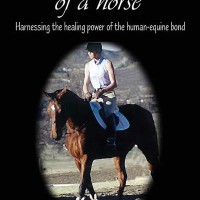
Swiss psychiatrist Carl Jung stressed the importance of becoming aware of the shadow self. According to Jung, the shadow is the unconscious complex characterized by the repressed, denied, or disowned parts of the self. It is, essentially those things that a person does not accept about himself or herself. Further, as this uncomfortable part of the self is often denied, it is also often projected onto others, which according to Jung is why a person should bring the shadow self into the conscious awareness. That is, to avoid projecting it onto others. However, this is clearly more easily said than done, as for some people, the existence of a shadow self alone is itself a scary concept. One can only imagine then the difficulty most therapists face in attempting to help a person accept the unwanted parts of themselves. So just imagine then how this might go in the arena with a 1200 pound animal.
For horses, there is no such thing as a shadow self. There is only the self — as is. There is no such thing as disguised material. Horses simply don’t have the time for this. As the eloquent stress researcher Robert Sapolsky says, “When your insides are hanging out, and the enemy is upon you, it is just not the time to worry about what your friends think of you.” This may seem a bit elementary or even primitive to some, but for a horse, it is daily reality. Survival, even for the domesticated horse, is still a foremost concern. That being said, herd communication among a group of equines must reflect this prominent need to survive. And guess what? Evasive communication just doesn’t cut it. So for a horse, neither does ours.
And we can’t anyway. If we were to measure stress hormones like cortisol or norepinephrine — the way Sapolsky does — as a way of identifying stress and non-stress states, we couldn’t lie. We may say, “I’m fine; I know what I’m doing with this horse,” but our indicative neurochemical levels would be off the chart. Well, this is exactly what a horse sees. Being non-verbal, horses have cut their teeth on the physiological barometer of stress, fine tuning their responses in ways to increase their survival chances. We would need to hook up any wiring to a horse to see this either. Watch a wild herd for a few minutes, and it is easy to see that the group response to stress happens so uniformly that it actually disguises the lightning speed communication between the members. In order to see it, a replay needs to be slowed to 25% of normal speed. Then in slow motion, one can decipher the chain of communication that occurs — first one horse, usually the lead or alpha horse, lifts his/her head in alarm, then a second horse, then another, and another, until all are at full attention and bolting across the field. So horses are experts — and much better than we are — at detecting stress among one another, and us as well.
And according to Jung, a shadow self that is beneath the conscious awareness leads to neurosis, otherwise known as stress. And hide it, project it, or deny it as we may, to a horse, it’s reason for alarm. But more than anything, it’s confusing for a horse, who has no capacity for understanding why things are hidden, that we would disguise a part of ourselves. But more importantly, to a horse, we cannot disguise anything, so our shadow self really comes across as a lie — something we are feeling, yet not acting on. And this, in the world of immediate and seamless communication, will not work. So, when left alone with a disguised person, a horse must address this hidden part of the self, as a way of preserving his own safety. After all, dishonesty about what is felt clearly impedes communication. And to a horse, when communication breaks down, safety is jeopardized. (Interesting to note that this is not the case with people.)
So as Jung encouraged us to look deeper, exploring the hidden meaning of symbols, animals, and events in our lives, we can perhaps take a lesson from our equine friends — maybe a nudge is not just a nudge.